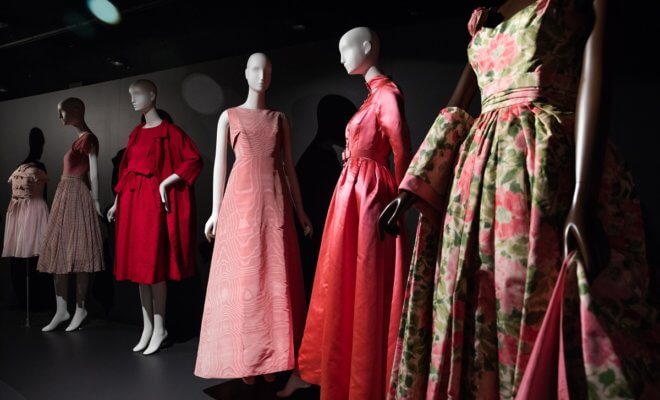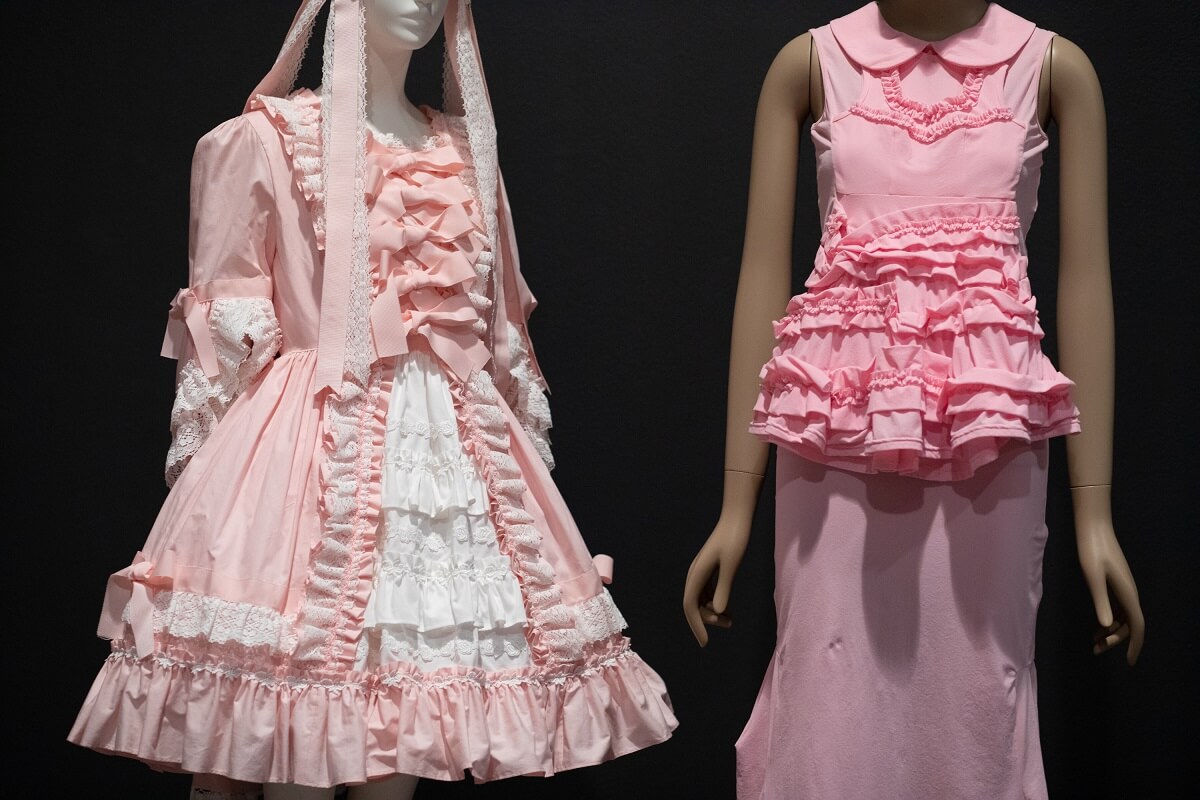Arts
Pink Isn’t What It Used to Be

Inside the exhibition "Pink: The History of a Punk, Pretty, Powerful Color," at the Fashion Institute of Technology in New York, Aug. 23, 2018.
Photo Credit: Jackie Molloy/The New York Times
Pink’s transgressive impact has been long in the making.
Pink packs a punch. The once playful tint of fragile ballerinas, Bubble Yum and Malibu Barbie has flexed some muscle of late, taking on overtones of sociopolitical protest, transgression and unalloyed eroticism.
That message emerges with unexpected force at the Fashion Institute of Technology in a museum exhibition that explores variations of a color that has ping-ponged across the centuries, varying in tone from demure to baldly subversive, from classy to trashy and back.
Pink is a color in transition — pretty, and pretty unsettling — in a show that opens Sept. 7. Its lingering kitsch factor has clouded its impact for sure.
“That’s one reason people think it’s not serious,” said Valerie Steele, the director of the Museum at FIT. Steele, on the other hand, would emphatically urge you to rethink pink.
“Really, it’s society that makes color, that decides what colors are going to mean,” she said, a point reinforced throughout the exhibition and in Steele’s accompanying book, “Pink: The History of a Punk, Pretty, Powerful Color.”
A multidimensional hue with widely varying connotations, it is no longer, Steele insisted, “just girlie dumb pink but androgynous, cool hip protesting pink, an expression of all kinds of more complicated ideas.”
The show makes her point, pink shedding its chaste, frothy associations in stealthy stages in favor of a more defiantly confrontational and sometimes downright kinky mood. Janelle Monáe mined that mood to the hilt with a copy of the ripely suggestive costume she wore in her recent video “Pynk.” That eye-searing look by Duran Lantink, a Dutch designer, is on view, its petal-like trousers opening to reveal a rosy-hued vagina.
Pink’s transgressive impact, though, has been long in the making. In Western culture the color, in near-magenta and faint, powdery variations, was embraced by the nobility, its popularity enhanced in the late 14th century when new dyes sourced from India and Sumatra made for richer pinks.
In the mid-1700s, Madame de Pompadour rendered a more confectionary pink the height of fashion: In the portraits of François Boucher, she models a succession of sassily beribboned shell-pink gowns and negligees.
Pink during that period was intended for both sexes, a point underscored in the exhibition by a mannequin showily attired in a coat and breeches, its pale salmon silk damask contrasting smartly with a creamy embroidered waistcoat.
But by the mid-19th century, men had largely ceded pink to their sisters and wives, any of whom might have worn the coy mid-1800s dress showcased at FIT, a pink silk taffeta gown, its multiple tiers bordered in an effusion of ruffles. Pink, as Steele writes, was perceived in those days as a pretty color expressive of delicacy and playful high spirits.
But pink also suggested a second skin. A lingerie tint with louche undertones, it was celebrated by Théophile Gautier in his 1850 poem “To a Pink Dress,” the poet rhapsodizing, “How I love you in that dress that undresses you so well.”

Inside the exhibition “Pink: The History of a Punk, Pretty, Powerful Color,” at the Fashion Institute of Technology in New York, Aug. 23, 2018. The exhibit explores glamour and subversiveness of this now ubiquitous color. Photo Credit: Jackie Molloy/The New York Times.
Times change and, with them, pink’s profile. By the late 19th century, pink was as common as ragweed. The introduction of aniline dyes that produced ultrabright, occasionally garish variations diminished the color’s prestige and rendered it vulgar, a tint flaunted in the novels of Emile Zola by shop girls and prostitutes.
Not for another half-century would pink be restored to a semblance of its former self, a hue both fancy and frivolous enough to be whipped into a ball gown by couturier Charles James. Propped high on a pedestal at the exhibition, James’ 1955 evening dress is a showstopper, a stole of black velvet opening like a flower to show off its faintly naughty rosy lining.
By the 1960s, pink had taken on a dual personality.It was sophisticated enough for Jackie Kennedy, who received the French minister André Malraux at the White House wearing a bonbon pink evening dress. And it was sexy enough for Marilyn Monroe, who gave pink a racy spin encased in a closefitting diamond studded pink evening dress in the 1953 film “Gentlemen Prefer Blondes.”
Pink went punk in the 1980s, a particularly garish shade known as Ultrapink enlivening the album covers of the Ramones, the Sex Pistols and X-Ray Spex.
A decade later, the color asserted itself on a global scale as the fashion insignia of self-proclaimed outliers: Madonna embraced pink’s bordello associations, performing in 1990 in a soft pink cone-cupped bustier by Jean Paul Gaultier. Pink became ubiquitous in Japanese girl culture, the blushing hue of mini-gangs of Lolitas roaming the Harajuku district in Tokyo.
The cultish color was taken up by American club crawlers, the emblem of cybergoths and ravers. More recently, it was appropriated by hip-hop culture. Turned out in pink mink and diamonds at New York Fashion Week in 2003, hip-hop artist Cam’ron lent the sugary hue some clout.
“People showed me so much love,” he later recalled. “I had to go out to Pantone and create my own color, which is called Killa Pink.”
With the years and shifting emphasis, pink turned political, the infamous pink triangle of the Nazi era repurposed by gay rights activists as a symbol of protest. Pink was taken up by a new generation of feminists as an assertion of proud womanhood, a trend that reached a crescendo at the 2017 inauguration when women descended on Washington en masse, flaunting quaintly homespun-looking pussy hats.
Around that time, pink took on a more knowing shading, as marketers and scores of young consumers made a run on the beiged, grayed and dusty variations known in aggregate as millennial pink, a color that spruced up a range of goods, including Scandinavian furniture and the Fenty label.
Fenty’s creator, Rihanna, improbably melded a boudoir mood with the aggressiveness of the playing field in a spring 2017 collection.
“I figured pink would be over by the time this show was up,” Steele said. But there are indications — Tom Ford’s pointy pink glitter shoes and the feathery pink ball gown Lady Gaga wore to the premiere of “A Star Is Born,” among them — that pink has yet to run its course.
“In terms of its meaning new things, pink has acquired the charisma and complexity of black,” Steele said. “Once it’s been interpreted as an androgynous and political color that speaks to young men and women of all races, there is no going back.”
© New York Times 2018
